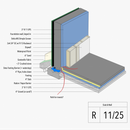Insects through an insulated slab?
We’ve sent a first draft of our basement assembly to our architect, and one of the concerns he came back with is a path for insects. Our basement is basically the H&H best practices slightly edited with information found on this site. Image attached. With that in mind, I have a few questions about the slab insulation and the transition to the walls.
1. Should the radon / vapor barrier under the slab act as an insect guard? If not, how would you protect against insects in this design? Sill plate over the gap between slab and wall, or something else?
2. Should the radon / vapor barrier under the slab “pop up” to slab level as shown in the picture, or go underneath the wall and connect to the footing barrier?
3. This assembly uses EPS under the slab. I just wanted to confirm whether or not this acts as an air barrier as well, or if an air barrier is not needed under the slab?
Thanks much for any advice – Ryan
GBA Detail Library
A collection of one thousand construction details organized by climate and house part










Replies
Deleted
If the vertical insulation along the slab edge is 3"/ R10 FoamGlas instead of EPS the insect path problem is solved.
https://industry.foamglas.com/en-gb/products/foamglas-one-insulation
https://industry.foamglas.com/en-gb/products/foamglas-hlb-insulation
https://www.buildinggreen.com/blog/foamglas---my-new-favorite-insulation-material
It's not clear how difficult it will be to find some now that they're no longer marketing it to the residential markets, but you don't need a lot:
https://www.finehomebuilding.com/2016/04/26/foamglas-insulation-exits-u-s-residential-market
A concrete slab is an air barrier, except at seams and cracks. A radon/vapor barrier gives it redundancy with or without the EPS. At 3" EPS is not a vapor barrier, and without sealing at the sheet seams it isn't air tight either. A broadsheet vapor/radon barrier works.
The radon/vapor barrier should indeed "pop up", to limit any capillary draw of ground or surface water in the foundation wall from entering the slab. The wall to radon/vapor barrier junction needs to be sealed. (Polyurethane caulk formulated for concrete would do it.)
Dana, thanks for the detailed reply. I'll see if I can get my hands on some FoamGlas. If not, would your advice be to:
a) Not worry about insects (termites, specifically) in this case. Just go with thick, quality vapor barrier sealed to wall.
b) Add a product (i.e.: http://www.polyguardproducts.com/2017/07/building-out-bugs-sill-plate-barriers/) that spans from under interior 2x4, under the wall EPS, to the foundation wall.
c) Something else. Borate treated EPS? Sand barrier along footings?
Points noted on the air barrier and "pop up" questions -- thank you for the clarifications.
Where will the house be located? That will determine your termite risk.
Wichita, KS
Compacted sand barriers would be the first line of defense, and should be used even if going with FoamGlas. An alternative to FoamGlas would be to insulate the slab edge with 6" autoclaved aerated concrete, but that's a more complicated approach than just substituting part of the EPS with FoamGlas.
If EPS it is, a layer of copper foil will stop most insects, and is toxic to the gut flora wood-boring insects need to be able to digest the cellulose. Even a tiny amount of copper leaching into the foam would do the trick, and the foil would be physical barrier as well. A copper clad plastic sill gasket extending at least an inch ether side of the foam at the top of the slab/wall juncture would do the trick. eg:
http://www.h-b.com/images/submittal/18MITEOUTTERM.pdf
Perfect, that clears it up for me. Thanks again.
HI Ryan -
Just an FYI : Atlas ThermalStar X-grade is an EPS rigid insulation formulated with an insecticide for use below grade.
https://www.atlaseps.com/files/LIT_1004_%28ThermalStar_X-Grade_PIS%29_121318.pdf
Peter
Appreciate it!
If the primary concern is termites, the soil inside and outside the foundation can be pretreated with termicides. In this application, the termicides can be effective for decades. If you want to use a non-chemical approach, in addition to the materials suggested above, there is a stainless steel mesh (http://www.termistopusa.com/) that provides termite protection for the life of the house. It could be cast-in to both the foundation and slab, bridging the gap between them. Stainless steel has a low conductivity and a mesh would be even lower, minimizing any thermal short.